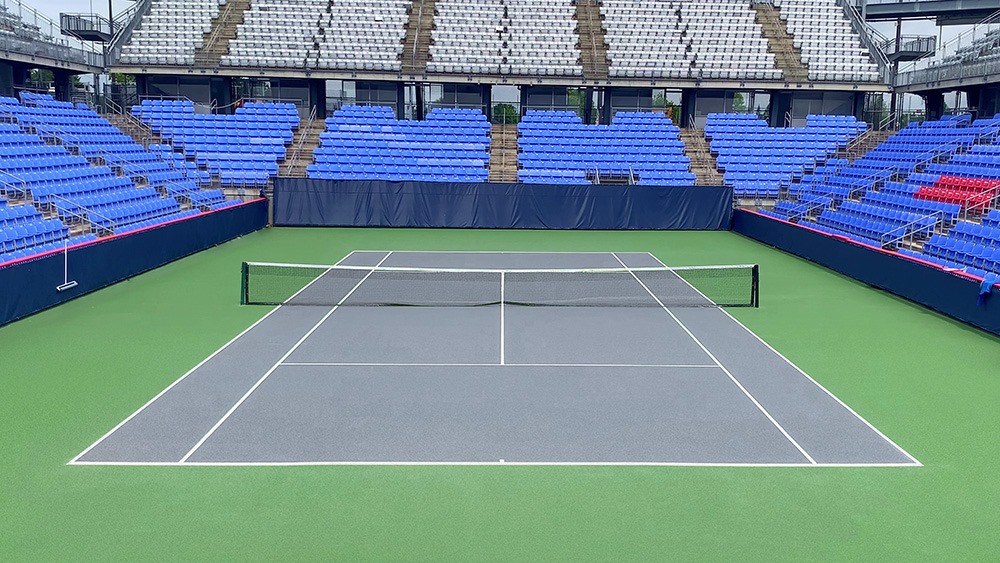Introduction:
In the realm of sports, tennis stands as a timeless pursuit, captivating enthusiasts with its blend of athleticism, strategy, and finesse. As the sport evolves, so too must the surfaces upon which it is played. Innovations in tennis court manufacturing have ushered in a new era of play, marked by enhanced performance, sustainability, and customization. At the forefront of this transformation is Pacecourt, a pioneering synthetic acrylic sports material manufacturer. By embracing cutting-edge technologies and sustainable practices, Pacecourt is reshaping the landscape of tennis court design and construction. This article explores the trends shaping the future of tennis court play and the pivotal role played by Pacecourt in driving innovation within the industry. From sustainable materials to smart court integration, the evolution of tennis courts reflects a commitment to excellence and a vision for a more dynamic and inclusive playing experience.
Innovations in Tennis Court Manufacturing
- Sustainable Materials:
- Adoption of eco-friendly materials such as recycled components to minimize environmental impact.
- Utilization of sustainable manufacturing processes to reduce carbon footprint.
- Advanced Surface Technologies:
- Incorporation of cutting-edge materials and surface treatments to optimize ball bounce, speed, and grip.
- Customization of surface textures to cater to diverse playing styles and preferences.
- Customization Options:
- Offering customizable court designs, colors, and branding elements to create unique and personalized playing environments.
- Integration of logos, graphics, and specific court markings tailored to client specifications.
- Smart Court Integration:
- Integration of sensors and tracking systems to provide real-time data analytics and feedback on player performance.
- Enhancement of training sessions and match experiences through interactive insights and engagement opportunities.
- Modular Construction:
- Adoption of modular court systems for faster, more efficient installation and maintenance.
- Facilitation of easy upgrades and modifications to meet evolving needs and preferences.
- Climate Adaptation and Resilience:
- Engineering surfaces to withstand extreme weather conditions, UV degradation, and moisture absorption.
- Ensuring year-round playability and longevity in diverse climates through resilient design and materials.
Future of Tennis Court Manufacturing
- Sustainable Practices:
- Increasing use of recycled materials and eco-friendly manufacturing processes to reduce environmental impact.
- Integration of renewable energy sources and sustainable design principles into court construction.
- Advanced Surface Technologies:
- Continued development of innovative materials and surface treatments to optimize performance, durability, and safety.
- Research into responsive surfaces that adapt to player movements and playing conditions in real-time.
- Smart Court Integration:
- Expansion of smart court technologies to provide players with personalized performance data and coaching insights.
- Integration of augmented reality and virtual reality features for immersive training and match experiences.
- Customization and Personalization:
- Advancements in customizable court designs, colors, and branding options to reflect individual preferences and brand identities.
- Incorporation of interactive elements such as LED lighting and multimedia displays for enhanced spectator experiences.
- Modular and Flexible Construction:
- Adoption of modular court systems for faster installation, easier maintenance, and adaptable court configurations.
- Exploration of flexible materials and construction techniques to accommodate changing playing styles and venue requirements.
- Climate-Resilient Surfaces:
- Development of climate-adaptive surfaces capable of withstanding extreme weather conditions and temperature fluctuations.
- Integration of sustainable drainage solutions to mitigate water runoff and ensure year-round playability in varying climates.
- Accessibility and Inclusivity:
- Emphasis on designing courts that are accessible to players of all ages, abilities, and socioeconomic backgrounds.
- Collaboration with community organizations and urban planners to promote the construction of public tennis facilities in underserved areas.
- Health and Safety Features:
- Implementation of antimicrobial surfaces and air purification systems to maintain cleanliness and hygiene on and around the courts.
- Incorporation of shock-absorbing materials and injury prevention technologies to reduce the risk of player injuries and fatigue.
- Collaboration and Innovation:
- Increased collaboration between manufacturers, designers, players, and governing bodies to drive continuous innovation and improvement in tennis court design and construction.
- Embracing emerging technologies such as 3D printing, nanotechnology, and biodegradable materials to push the boundaries of what is possible in tennis court manufacturing.
Role of Pacecourt Materials in Innovation
- Sustainable Solutions:
- Pacecourt prioritizes the use of sustainable materials in its tennis court surfaces, contributing to the industry’s shift towards eco-friendly practices.
- By incorporating recycled components and employing energy-efficient manufacturing processes, Pacecourt reduces environmental impact without compromising performance.
- Advanced Performance:
- Pacecourt’s proprietary materials and surface technologies enhance the performance of tennis courts, providing players with consistent ball bounce, traction, and durability.
- Through ongoing research and development, Pacecourt continues to innovate, pushing the boundaries of what is possible in terms of playability and resilience.
- Customization Options:
- Pacecourt offers a range of customization options, allowing clients to tailor their tennis court designs to meet their specific preferences and branding requirements.
- Whether it’s incorporating logos, graphics, or unique color schemes, Pacecourt materials enable venues to create distinctive and personalized playing environments.
- Smart Court Integration:
- Pacecourt collaborates with technology partners to integrate smart court features into its surfaces, providing players with access to real-time performance data and coaching insights.
- By incorporating sensors and tracking systems, Pacecourt materials facilitate the implementation of advanced training programs and match analysis tools.
- Modular Construction:
- Pacecourt’s materials are designed for modular construction, offering faster installation and easier maintenance compared to traditional court surfaces.
- This flexibility allows venues to adapt and expand their tennis facilities more efficiently, minimizing downtime and maximizing usability.
- Climate Adaptation and Resilience:
- Pacecourt materials are engineered to withstand a range of climatic conditions, ensuring year-round playability and longevity.
- By offering surfaces that are resistant to UV degradation, moisture absorption, and temperature fluctuations, Pacecourt enhances the resilience of tennis courts in diverse environments.
Conclusion:Innovation is at the heart of the evolution of tennis court manufacturing, and Pacecourt stands as a pioneering force driving this transformation. Through its commitment to sustainability, advanced performance technologies, customization options, smart court integration, modular construction solutions, and climate-adaptive surfaces, Pacecourt is redefining the standards of excellence in the industry. By prioritizing environmental responsibility, performance, and inclusivity, Pacecourt materials enable tennis venues to create personalized, high-quality playing environments that cater to the diverse needs of players and spectators alike.

